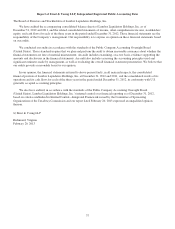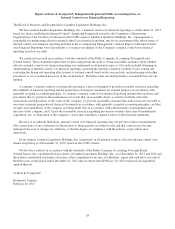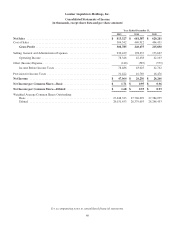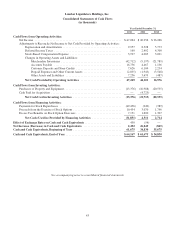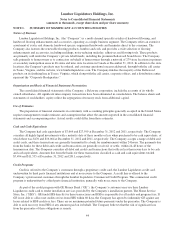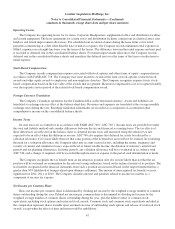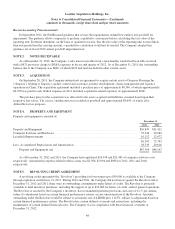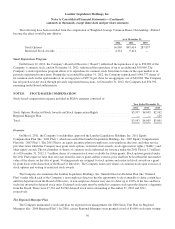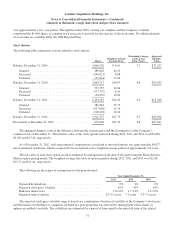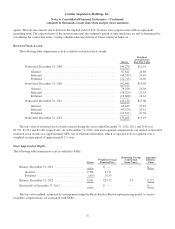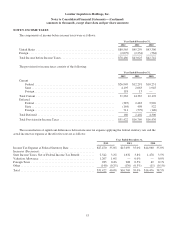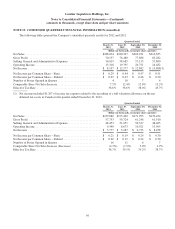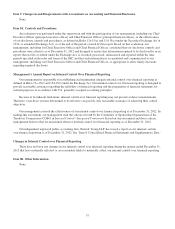Lumber Liquidators 2012 Annual Report Download - page 53
Download and view the complete annual report
Please find page 53 of the 2012 Lumber Liquidators annual report below. You can navigate through the pages in the report by either clicking on the pages listed below, or by using the keyword search tool below to find specific information within the annual report.Lumber Liquidators Holdings, Inc.
Notes to Consolidated Financial Statements—(Continued)
(amounts in thousands, except share data and per share amounts)
Operating Leases
The Company has operating leases for its stores, Corporate Headquarters, supplemental office and distribution facilities
and certain equipment. The lease agreements for certain stores and distribution facilities contain rent escalation clauses, rent
holidays and tenant improvement allowances. For scheduled rent escalation clauses during the lease terms or for rental
payments commencing at a date other than the date of initial occupancy, the Company records minimum rental expenses in
SG&A expenses on a straight-line basis over the terms of the leases. The difference between the rental expense and rent paid
is recorded as deferred rent in the consolidated balance sheets. For tenant improvement allowances, the Company records
deferred rent in the consolidated balance sheets and amortizes the deferred rent over the terms of the leases as reductions to
rental expense.
Stock-Based Compensation
The Company records compensation expense associated with stock options and other forms of equity compensation in
accordance with FASB ASC 718. The Company may issue incentive awards in the form of stock options, restricted stock
awards and other equity awards to employees and non-employee directors. The Company recognizes expense for its stock-
based compensation based on the fair value of the awards that are granted. Measured compensation cost is recognized ratably
over the requisite service period of the related stock-based compensation award.
Foreign Currency Translation
The Company’s Canadian operations use the Canadian dollar as the functional currency. Assets and liabilities are
translated at exchange rates in effect at the balance sheet date. Revenues and expenses are translated at the average monthly
exchange rates during the year. Resulting translation adjustments are recorded as a component of accumulated other
comprehensive income on the consolidated balance sheets.
Income Taxes
Income taxes are accounted for in accordance with FASB ASC 740 (“ASC 740”). Income taxes are provided for under
the asset and liability method and consider differences between the tax and financial accounting bases. The tax effects of
these differences are reflected on the balance sheet as deferred income taxes and measured using the effective tax rate
expected to be in effect when the differences reverse. ASC 740 also requires that deferred tax assets be reduced by a
valuation allowance if it is more likely than not that some portion of the deferred tax asset will not be realized. In evaluating
the need for a valuation allowance, the Company takes into account various factors, including the nature, frequency and
severity of current and cumulative losses, expected level of future taxable income, the duration of statutory carryforward
periods and tax planning alternatives. In future periods, any valuation allowance will be re-evaluated in accordance with
ASC 740, and a change, if required, will be recorded through income tax expense in the period such determination is made.
The Company recognizes the tax benefit from an uncertain tax position only if it is more likely than not that the tax
position will be sustained on examination by the relevant taxing authorities, based on the technical merits of its position. The
tax benefits recognized in the financial statements from such a position are measured based on the largest benefit that has a
greater than 50% likelihood of being realized upon ultimate settlement. The amount of unrecognized tax benefits was not
significant for 2012, 2011 or 2010. The Company classifies interest and penalties related to income tax matters as a
component of income tax expense.
Net Income per Common Share
Basic net income per common share is determined by dividing net income by the weighted average number of common
shares outstanding during the year. Diluted net income per common share is determined by dividing net income by the
weighted average number of common shares outstanding during the year, plus the dilutive effect of common stock
equivalents, including stock options and restricted stock awards. Common stock and common stock equivalents included in
the computation represent shares issuable upon assumed exercise of outstanding stock options and release of restricted stock
awards, except when the effect of their inclusion would be antidilutive.
47


